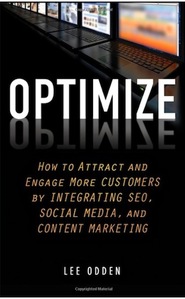
Small and medium businesses face a number of challenges inherent to their size; many simply don’t have the budget, manpower, or in-house expertise to pull off the online marketing campaigns bigger companies can manage.
Selling online has this wonderful equalizing factor, making it possible for even the sole entrepreneur working from home to connect with markets they otherwise may never have accessed. However, as search engines continue to evolve, placing more and more emphasis on content and user experience, many SMBs are finding it difficult to compete with competitors that may have the capacity to churn out content, win in social, and outrank them at every turn.
Lee Odden, author of “Optimize: How to Attract and Engage More Customers by Integrating SEO, Social Media and Content Marketing,” offered to help us solve five common SMB online marketing problems. We receive a lot of questions and feedback at Search Engine Watch through comments, emails, social media contacts, and at events like SES. A number of problematic issues have cropped up in conversation with SMB owners and entrepreneurs:
- They know their website needs major work but don’t know where to start.
- Content creation is daunting and time consuming.
- They’re trying different things in social but don’t know what to do if one channel doesn’t pan out or they have to choose to focus on just one.
- They have too much social data to digest and aren’t sure which metrics matter, or if it’s worth the effort.
- They know they should be more active online but need time to actually run their business.
So what is a marketer with limited resources to do? Though there are no one-size-fits-all solutions, Odden’s recommendations can help get your SMB web presence optimized and on the right track.
1. Website Needs Work? Start With an Audit and Prioritize to Make a Site Overhaul Manageable

This seems to be one of the bigger issues plaguing SMBs. Often, many small changes and updates are made over the years, without much thought as to how these constant tweaks affect the site as a whole. When a website no longer lives up to what users or search engines expect of it, where do you even begin?
“A site evaluation through audits can help determine how much of an asset the website is currently and can be in the future,” said Odden. As to what that should entail, he recommends, “An SEO audit will cover keywords, technical/code, SEO copywriting, the linking footprint and social presence. Through the audit, a sort of GAP analysis can be conducted to identify where the site needs attention for most impact.”
Odden shared the example of a medium-sized business site with thousands of pages, with a simple SEO error of duplicate title tags. This might be updated using basic programming to extract content off the page (like product names) to dynamically populate title tags, he said. If the site has many, many articles that are frequently found through search and have a good number of social referrals, then embedding social share functionality can increase social distribution of those articles just by making it easy.
“In most cases, the low hanging fruit identification comes from having an evaluation of the website and expertise to determine where to apply resources in order to reach business goals,” Odden explains. Use an audit to identify problems and opportunities, then prioritize and take action.
2. Uninspired? Ongoing Engagement Means You’ll Never Run Out of Things to Talk (or Write) About
 We asked Odden what advice he has for entrepreneurs who have shied away from blogging and/or social because they don’t feel they can produce enough contenton a regular basis to keep things interesting.
We asked Odden what advice he has for entrepreneurs who have shied away from blogging and/or social because they don’t feel they can produce enough contenton a regular basis to keep things interesting.
“I often say, ‘If a company doesn’t have anything interesting to say, they have bigger problems to solve than where their next blog post is coming from,’ Odden responded. He knows it’s a bit of a jibe, but it does reflect the need for a change in perspective. He notes that, “Many companies see themselves as a vessel, with a finite number of ideas and pieces of information. In other words, their view of content is fairly static and self-centered. Once they’ve said all there is to say about their own products and services, the well goes dry.”
Instead, marketers need to look at blogging as a byproduct of the ongoing listening and engagement between a brand and its customers, he advises. “A change in perspective that allows the brand to see things from their customer’s perspective with empathy can reveal many opportunities for making observations, answering questions and interacting with the community through blog content,” said Odden. “Just checking for commonly asked questions that customer service and sales people hear can be a rich source of blogging ideas.”
A few other tips and tools Odden recommends for ongoing information to inspire content creation:
- Social media analytics data.
- Social media monitoring tools with suggested topics related to areas of interest around products and services being tracked.
- Web analytics can reveal questions people most often use on Google that send them to the company website. Blog posts can be planned to answer those questions.
Odden has been blogging as a business owner for more than eight years and he understands the challenges in regular content creation.
The key to persistent, productive blogging, he said, is to “have a plan, be adaptable and use blogging as a platform to share useful information that provides value to readers but also reinforces sales, referrals and social shares. Ongoing engagement will mean a never ending source of things to blog about.”
3. Social Not Panning Out? How to Cut Your Losses Without Killing the Channel

This is a unique challenge that happens more often than you might suspect. We asked Odden how SMBs should handle social channels that just haven’t worked out enough to justify ongoing management. Once you’ve given Facebook or Twitter an honest shot, is it better to delete the account if it’s not meeting your goals, continue without much of a presence, or is there another alternative?
Odden had some creative recommendations for SMBs, noting that he would approach it differently, depending to what the goal was and what social platform was being used.
“On Twitter, I might just discontinue manually posting to the account and determine it to be a source of news information,” he said. In order to accomplish this, Odden told us he would do a relevant query on Google News, take the RSS feed of the search results for that query and run it through Twitter feed and populate the account with news stories once or twice a day.
“I’d still check the account once a day for engagement opportunities, but I’d probably not kill it if it can continue to provide some value,” he offered. He would only consider deleting the account if it could not provide value and there is no chance of it being used again.
He would approach a struggling blog differently, Odden notes.
“Then I might absorb the past posts into a resource center format without comments, but still organized by category. It would not look like a blog but more like a collection of articles on topics that would be useful to prospects and customers,” he said.
In this case, he would discontinue daily or weekly blogging but new articles could be added from time to time, possibly incorporated into a company newsletter or as bylined articles in industry media.
4. Drowning in Social Data? Learn to Track & Measure What Helps You Achieve Your Goals
Big companies have teams analyzing trends in their social data, measuring goals, making recommendations… where should a smaller business even begin?
“Optimize” offers insight into identifying goals that work in tandem with measurement.
“The first step in understanding social KPIs (key performance indicators) and business objectives is to establish what the goals are,” Odden said. “In many cases, goals might emphasize customer acquisition or revenue. There are other revenue oriented goals that can be affected by integrated SEO, social media and content marketing like the length of sales cycle, order volume, order frequency, per transaction profitability and referrals.”
Other goals covered in the book deal with increasing the effectiveness of PR objectives like awareness and building thought leadership. Yet other goals may augment content reach and effectiveness, for customer service or talent acquisition.
“The social KPIs worth measuring should help you track progress towards your goal,” Odden recommends. “For example, if you think better search ranking of optimized content will result in more qualified visitors and sales, then the things that affect ranking are KPIs worth tracking, such as inbound links, social shares and other SEO metrics.”
In another example Odden shared, he uses the premise that the number of unsolicited media pickups will increase if the brand can become present in the social streams and news feeds of key journalists and bloggers that cover the industry. In that case, he advises, you would work social engagement and content into your social media tactics. Social KPIs might be the number of retweets and shares of your targeted stories, the direct interactions with bloggers and media through comments, shared content and direct messages.
5. Stretched Too Thin? Try Working With Online Marketing Consultants
SMBs, in particular, may not be able to justify the overhead to hire online marketing talent to work in-house. What should they be looking for if they decide to outsource?
“The industry is mature enough that outside consultants should be able to show that they have experience implementing solutions and solving difficult problems using an intentional approach vs. social or SEO guesswork,” Odden said. “In many cases, it makes sense for a SMB to engage a consultant at a strategic level who can provide assistance with overall approach and oversight of implementation. For others, the need for niche expertise is what’s needed.”
Either way, he said, marketing professionals should be able to listen and understand the nature of the SMBs business problem and offer a thoughtful approach and tactics to solve it. Some things can be done by the SMB and some by the consultant.
For more of Odden’s tips and advice on integrating SEO, social media and content marketing, get “Optimize” online from Barnes & Noble or Amazon, or grab your copy in-store. If you have more SMB online marketing questions, let us know in the comments!


 We asked Odden what advice he has for entrepreneurs who have shied away from blogging and/or social because they don’t feel they can
We asked Odden what advice he has for entrepreneurs who have shied away from blogging and/or social because they don’t feel they can 